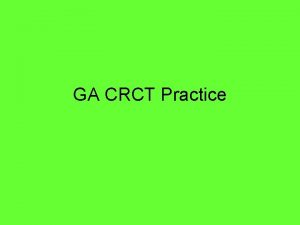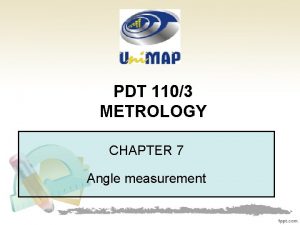Defining Terms This statement defines a protractor A























- Slides: 23

Defining Terms This statement defines a protractor: “A protractor is a geometry tool used to measure angles. ” First, you classify what it is (a geometry tool), then you say how it differs from other geometry tools (it is the one you use to measure angles).

Parallel Lines Notation: h // g Picture markings for parallel lines Definitions: Parallel lines are coplanar lines that do not intersect. Skew lines are non-coplanar lines that do not intersect Line a is skew to line b

Perpendicular Lines l k Definition: Perpendicular lines are intersecting lines that form 90˚ angles.

7 Angle relationships to define Right angle Acute angle Obtuse angle Complementary angles Supplementary angles Linear pair of angles Vertical angles

Textbook Investigation: Lesson 1. 3 http: //acr. kendallhunt. com/Key. Press Portal. V 5. 0/Viewer/Home. Frame. htm

Types of Angles An Acute angle is an angle that measures between 0° and 90° A Right angle is an angle that has a measure of 90° An Obtuse angle is an angle that measures between 90° and 180°

Complementary Angles Complementary angles are two angles whose sum of their degree measurements equals 90 degrees. Example: These two angles are complementary. Their sum is 90˚. 58° + 32° = 90°

Adjacent Complementary Angles. Those same two angles can be "pasted" together to form a right angle! These 2 angles are adjacent – they share a vertex and a side.

Supplementary Angles Supplementary angles are two angles whose sum of their degree measurements equals 180 degrees. Example: These two angles are supplementary. The sum of their measures is 180˚ 139° +41° = 180 °

Linear Pair of Angles Adjacent Supplementary Angles A linear pair of angles are two angles that are adjacent and supplementary angles.

Linear Pair of angles A linear pair of angles are two angles that are adjacent and supplementary angles. Conjecture: If two angles form a linear pair, then they are supplementary.

Vertical Angles Vertical angles are opposite angles formed by intersecting lines. For any two lines that meet, as in the diagram below, <AEB and <DEC are called vertical angles. <BEC and <AED are also vertical angles.

Vertical Pair of Angles Vertical angles are two angles that are created by two intersecting lines and are opposite each other. < 1 & <3 are a vertical pair of angles < 2 & <4 are a vertical pair of angles Conjecture: If two angles are vertical angles, then they are congruent.

Angles Around a Point Angles around a point will always add up to 360 degrees. The angles above all add to 360° 53° + 80° + 140° + 87° = 360°

We can find an unknown angle using this sum. Example: What is angle “C"? C To find the measure of < C, find the sum of the known angles and subtract that from 360°. Sum of known angles = 110° + 75° + 50° + 63° = 298° m< C = 360° − 298° m < C = 62°


Review State whether the following are acute, right, or obtuse. 1. 3. 2. 5. 4. ? ?

Complementary and Supplementary Find the missing angle. 6. Two angles are complementary. One measures 65 degrees. 7. Two angles are supplementary. One measures 140 degrees.

Complementary and Supplementary Find the missing angle. You do not need a protractor. Use the clues in the pictures. 8. 9. x 55° x 165°

Vertical Angles & Linear Pair 10. Find the missing angles. You do not need a protractor. Use the clues in the pictures. y 58° x

More drawings 11. Find the measure of all the angles with vertex C E D F C G J H Box in the corner indicates a right angle.

Final Drawing 12. Find the measure of all the angles with vertex G. B C G A F D E

 Non defining
Non defining Relative clauses defining and non defining
Relative clauses defining and non defining Relative clauses defining and non defining
Relative clauses defining and non defining Defining and non defining relative clauses in telugu
Defining and non defining relative clauses in telugu Defining and non-defining relative clauses arasındaki fark
Defining and non-defining relative clauses arasındaki fark Non essential adjective clause
Non essential adjective clause Defining terms geometry
Defining terms geometry Which statement best defines cold chain management
Which statement best defines cold chain management Which best summarizes the structure of the roman government
Which best summarizes the structure of the roman government Which statement best defines the term civil liberties?
Which statement best defines the term civil liberties? Which statement best describes this part of the story?
Which statement best describes this part of the story? Which statement best defines a cell
Which statement best defines a cell What is meant by an iteration goal
What is meant by an iteration goal Which statement best defines cold chain management
Which statement best defines cold chain management What statement defines the dynastic cycle
What statement defines the dynastic cycle 5 levels of planning agile
5 levels of planning agile Polynomial degrees and terms
Polynomial degrees and terms Math combining like terms
Math combining like terms Sine table in metrology
Sine table in metrology Frank stella protractor series
Frank stella protractor series Constructing triangles worksheet
Constructing triangles worksheet Uncertainty of slope
Uncertainty of slope Orient a map to the ground by map-terrain association
Orient a map to the ground by map-terrain association Protractor uncertainty
Protractor uncertainty













































